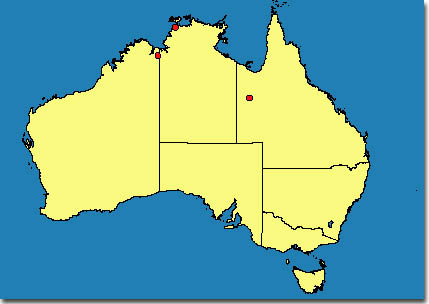

 |
 |
||
|
|
|||
| Diagnosis | Encarsia adusta Schmidt & Naumann |
|||||||||||||
| Species group | ||||||||||||||
| Distribution | ||||||||||||||
| Host | ||||||||||||||
| Comments | ||||||||||||||
| Illustrations | ||||||||||||||
| DNA | ||||||||||||||
| Encarsia adusta Schmidt & Naumann, 2001. Holotype female, Northern Territory, Darwin, 27.ix.1996 (P. De Barro) ex B. tabaci on Sonchus oleraceus (ANIC). | ||||||||||||||
Diagnosis |
FemaleColourHead predominantly brown, upper head partly lighter. Overall colouration of mesosoma light brown, scutellum slightly lighter and propodeum darker than rest of mesosoma. Petiole brown. Gaster predominantly brown, at base with sharply defined narrow dark brown band. Antenna yellow with scape, pedicel and apical segments darkened. Fore wing hyaline. Legs yellow except coxa basally brown and hind femur darkened. MorphologyHead with rugose-reticulate surface sculpture. Clava 2-segmented. Pedicel longer than F1 (1.35-1.62). F1 1.44-1.80 x as long as wide, slightly shorter than F2 (0.72-0.85) and F3 (0.68-0.81). Flagellomers with the following numbers of sensilla: F1: 0, F2: 2, F3: 2, F4: 3, F5: 3, F6: 3. Mid lobe of mesoscutum with 8(-9) setae arranged symmetrically, side lobes with 3 setae each. Mesoscutal midlobe, axillae, and scutellum with rather fine but distinctive reticulation, cells with distinct internal striations. Scutellar sensilla widely separated, approximately 5-6 x the width of a sensillum. Distance between anterior pair of scutellar setae larger than between posterior pair. Fore wing 2.6 x as long as wide. Marginal fringe 0.35-0.38 x as long as wing width. Submarginal vein with 2 setae, marginal vein anteriorly with 7 setae. Tarsus of middle leg 5-segmented. Apical spur of midtibia subequal to half the length of the corresponding basitarsus (0.44-0.55). Tergites laterally with the following number of setae: T2: (2-)3-6(-8), T3: 3-6, T4: 3-6, T5: 4-6, T6: 4-6, T7: 3. T8 with 4 setae. Ovipositor slightly shorter than or subequal in length to middle tibia (0.90-1.03). Third valvula 0.44-0.46 x as long as second valvifer. MaleBody predominantly brown with mesoscutal midlobe posteriorly and scutellum lighter. Legs light brown except coxae brown, femora, in particular hind femur, lighter brown and tibiae slightly darkened. Apical two segments of flagellum fused and sensilla partly overlapping. |
|||||||||||||
Species
|
Placed in Encarsia inaron-group |
|||||||||||||
Distribution
|
 Click here for material examined window. |
|||||||||||||
Host |
B. tabaci (Gennadius), Lipaleyrodes sp., Trialeurodes vaporariorum (Westwood). |
|||||||||||||
Comments |
Encarsia adusta, together with E. accenta and E. azimi, belongs to the E. inaron species group. Encarsia azimi is sometimes difficult to distinguish from E. adusta but has usually a pale yellow gaster and only 1-2 (rarely 3) setae on each side of the third and fourth tergites. Encarsia accenta has a distinct colour pattern and differs morphologically by the short tibial spur of the middle leg, which is distinctly shorter than half the length of the corresponding basal tarsal segment. The 28S rDNA D2 gene region shows consistent differences and characterizes each species on a molecular level (see Babcock et al., 2001). |
|||||||||||||
|
|
||||||||||||||
Illustrations |
|
|||||||||||||
DNA
|
28S-D2 rDNA: GenBank Accession Code: AF254230. |
|||||||||||||
| © Copyright 2001, CSIRO Australia |
| [webmaster - February 2001] |
| Use of this web site and information available from it is subject to our |
| Legal Notice and Disclaimer |